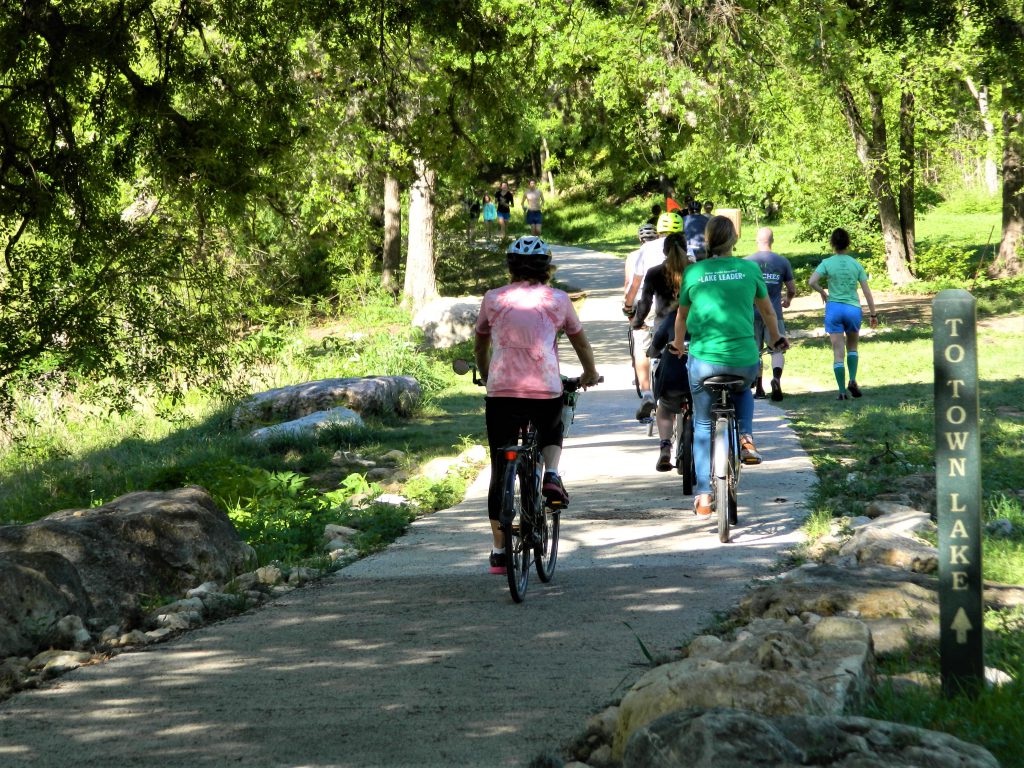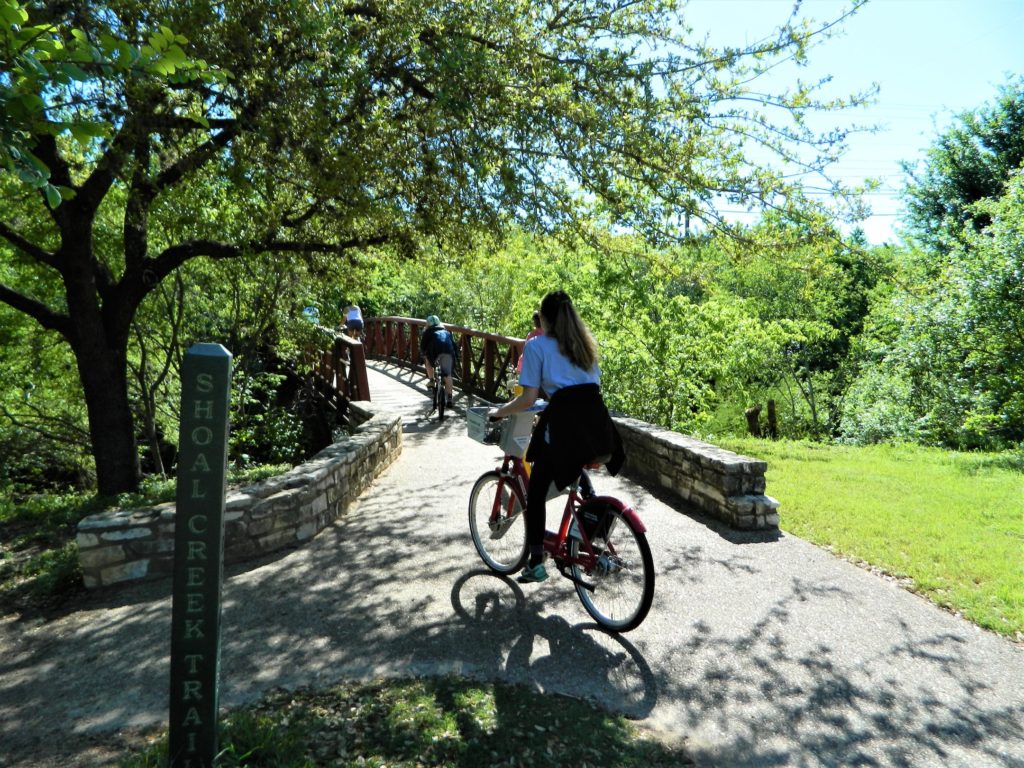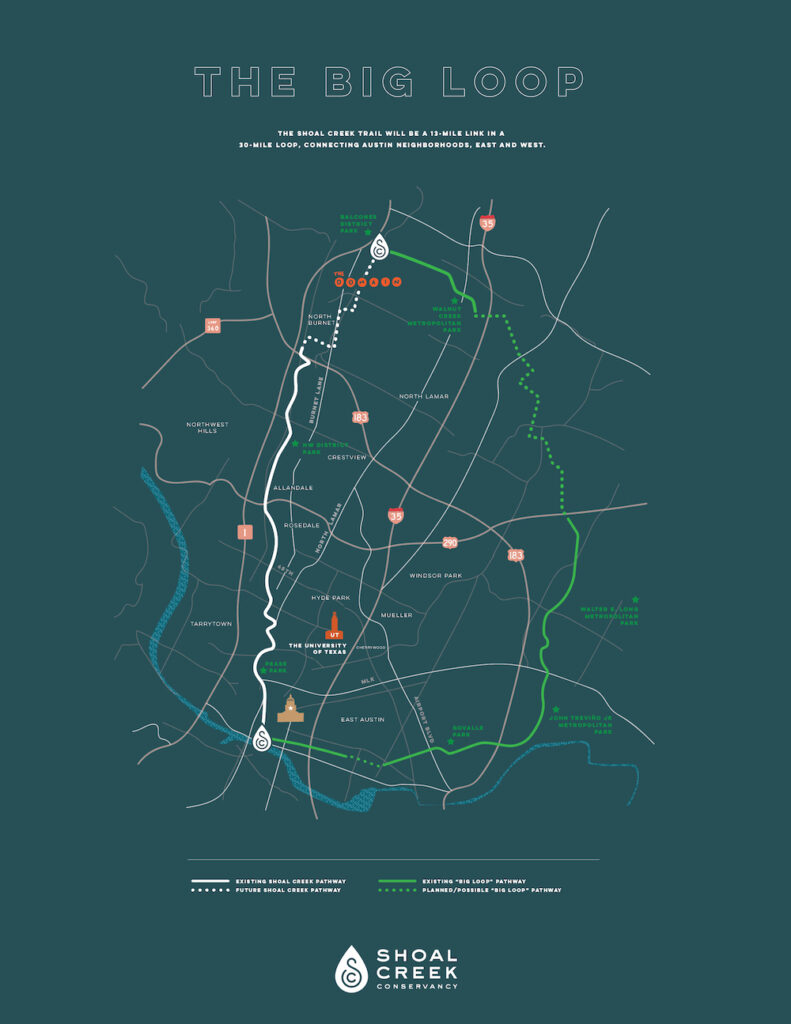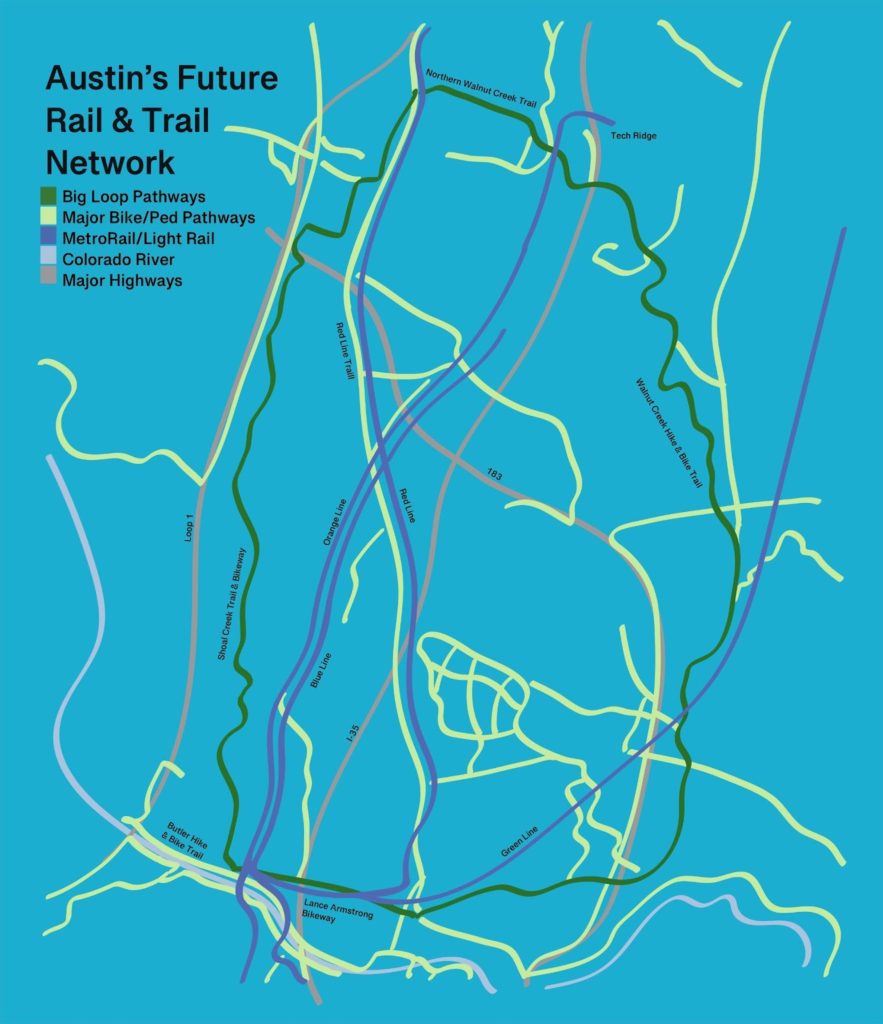A Commute for the Future
May 17, 2022 | By Shoal Creek Conservancy
Austin is growing – this we all know. With that comes new neighbors, new additions to the downtown skyline, and – of course – more traffic. If you’re reading this, you’re probably aware of and you may have voted for Project Connect: Austin’s ambitious and transformative new mobility plan. Light rail and downtown subways are certainly exciting, but changes in the way we move about the city aren’t exclusive to roads and railways. Urban trails and bikeways such as Shoal Creek offer great, healthy, and enriching options to your daily commute and form a vital component of Austin’s evolving multimodal transportation network.
In 2021, Austin drivers lost an average of 74 hours to rush hour traffic. According to the Census Bureau, the city gained 116 new residents each day last year. Choosing to bike or walk along urban trails removes you from congested streets and helps you avoid the worsening traffic. Instead, you can move through the city through its natural corridors, enjoy beautiful local flora and fauna on your way to the office, and feel a greater connection to your community than you can while sitting on I-35. The City of Austin and Austin voters have seen the amazing possibilities with urban trails and have integrated them into future transportation plans.
In 2019, Austin City Council adopted the Austin Strategic Mobility Plan (ASMP). Along with roadway and public transportation improvements, bicycling and urban trails are included in this guide for all transportation plans, policies, programs, and projects within the city for the next two decades. The ASMP does this by setting certain targets for the future that aim to diversify our transportation network and get more cars off the road during rush hour. Many of these goals and targets align with Shoal Creek Trail Plan adopted one year earlier in 2018.
The ASMP aims to increase the share of Austin residents who bike to work from 1.3% (2013-2017) to 4% by 2039. To achieve this goal, the city is focused on decreasing bicycle travel time by removing significant infrastructure gaps that make bike commuting a challenge. This theme of connectivity and access is the guiding principle behind Shoal Creek Conservancy’s 2018 Trail Plan. The joint vision between the City of Austin and SCC has made it possible today for commuters and families to safely bike to Lady Bird Lake from Highway 183 and access a greater portion of the city without getting behind the wheel.

Even if you don’t ride a bicycle or live within the Shoal Creek Watershed, improvements in urban trails have the potential to dramatically change the way you get around. Let’s imagine you live around Ben White Boulevard, and your workplace is around 9th Street and Lamar Boulevard. Today, you probably spend up to five hours a week staring at other people’s license plates while stuck in traffic and a significant amount of money on car maintenance, gasoline, and parking. Less reliance on cars for transportation can have a large impact on how we spend our time and money, and our overall happiness.
Within the next decade, you will have other options. Rather than sitting on Mopac, you can hop on the light rail at the South Congress Transit Center and take the Orange Line up to the new Republic Square Underground Station. No changing lanes, no searching for a parking space: you can relax, read, check your phone, and get prepared for the day while the train gets you downtown safely. You come up to the street level and walk two blocks west to the Rio Grande Pedestrian Bridge to follow the Shoal Creek Urban Trail to your destination. A bike or micromobility device like a scooter will get you up the creek quickly, or you can take the ten/fifteen minute walk through the urban greenbelt as a peaceful decompression exercise before or after your workday. Which would you prefer: starting your day with honking and the screeching of tires, or with birdsongs and the trickling of water? Project Connect, the ASMP, and the Shoal Creek Trail Plan are actively making this future possible.

Shoal Creek is eleven miles long, stretching from Highway 183 to Lady Bird Lake, and it makes up just one portion of Austin’s beautiful natural landscape that includes three distinct ecoregions: the Northern Blackland Prairie, the Edwards Plateau, and the Oak Woods and Prairies. A better mobility network means greater access to every great part of our city and more chances to explore unique natural environments. That’s what’s behind the vision of the “Big Loop” Trail: a grand-scale network that connects major trails north of the Colorado River.
 Once gaps between major trails are reconciled, the Big Loop will allow Austinites to walk, run, or bike from the Butler Trail at Lady Bird Lake up to the Walnut Creek Trail at the Domain by way of the Shoal Creek Trail, then southeast to the Lance Armstrong Bikeway back downtown. The 30-mile loop will eventually frame a network connecting other trails such as the Red Line Trail, Mueller Trail, Colorado River Trail, and Violet Crown Trail extending down to Hays County. The expansion of these urban trails will make transportation opportunities like previously described possible for every resident on their way to work, the store, school, or anywhere else they need to go.
Once gaps between major trails are reconciled, the Big Loop will allow Austinites to walk, run, or bike from the Butler Trail at Lady Bird Lake up to the Walnut Creek Trail at the Domain by way of the Shoal Creek Trail, then southeast to the Lance Armstrong Bikeway back downtown. The 30-mile loop will eventually frame a network connecting other trails such as the Red Line Trail, Mueller Trail, Colorado River Trail, and Violet Crown Trail extending down to Hays County. The expansion of these urban trails will make transportation opportunities like previously described possible for every resident on their way to work, the store, school, or anywhere else they need to go.
The Austin Strategic Mobility Plan highlights an interconnected urban trail network as a crucial tool for achieving 50/50 mode share by 2039 – as in, half of Austinites getting around without a car. This goal may seem overly ambitious, but only because we are so used to our commutes detracting from our lives rather than enriching them. Our experience of a city is significantly influenced by the time we spend getting from here to there. As Austin grows and develops, we have a unique opportunity to shape the fabric of our city for the better of our communities and the environment. Our efforts through projects such as the Austin Strategic Mobility Plan, Project Connect, and Shoal Creek Trail Plan will result in a safer, healthier, happier, and more livable city for us all.

Written by Kit Hagin, SCC’s Spring 2022 Sustainability Intern
